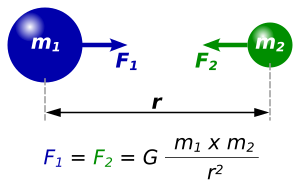
Back ثابت الجاذبية Arabic Constante de gravitación universal AST کوتله چکیمی ثابیتی AZB Гравітацыйная пастаянная Byelorussian Гравітацыйная канстанта BE-X-OLD Гравитационна константа Bulgarian মহাকর্ষ ধ্রুবক Bengali/Bangla Constant de la gravitació Catalan نەگۆڕی ڕاکێشان CKB Gravitační konstanta Czech
| Value of G | Unit |
|---|---|
| 6.67430(15)×10−11[1] | N⋅m2⋅kg−2 |
| 6.67430(15)×10−8 | dyn⋅cm2⋅g−2 |
| 4.3009172706(3)×10−3 | pc⋅M⊙−1⋅(km/s)2 |

The gravitational constant is an empirical physical constant involved in the calculation of gravitational effects in Sir Isaac Newton's law of universal gravitation and in Albert Einstein's theory of general relativity. It is also known as the universal gravitational constant, the Newtonian constant of gravitation, or the Cavendish gravitational constant,[a] denoted by the capital letter G.
In Newton's law, it is the proportionality constant connecting the gravitational force between two bodies with the product of their masses and the inverse square of their distance. In the Einstein field equations, it quantifies the relation between the geometry of spacetime and the energy–momentum tensor (also referred to as the stress–energy tensor).
The measured value of the constant is known with some certainty to four significant digits. In SI units, its value is approximately 6.674×10−11 N⋅m2/kg2.[1]
The modern notation of Newton's law involving G was introduced in the 1890s by C. V. Boys. The first implicit measurement with an accuracy within about 1% is attributed to Henry Cavendish in a 1798 experiment.[b]
- ^ a b "2022 CODATA Value: Newtonian constant of gravitation". The NIST Reference on Constants, Units, and Uncertainty. NIST. May 2024. Retrieved 18 May 2024.
Cite error: There are <ref group=lower-alpha> tags or {{efn}} templates on this page, but the references will not show without a {{reflist|group=lower-alpha}} template or {{notelist}} template (see the help page).
© MMXXIII Rich X Search. We shall prevail. All rights reserved. Rich X Search